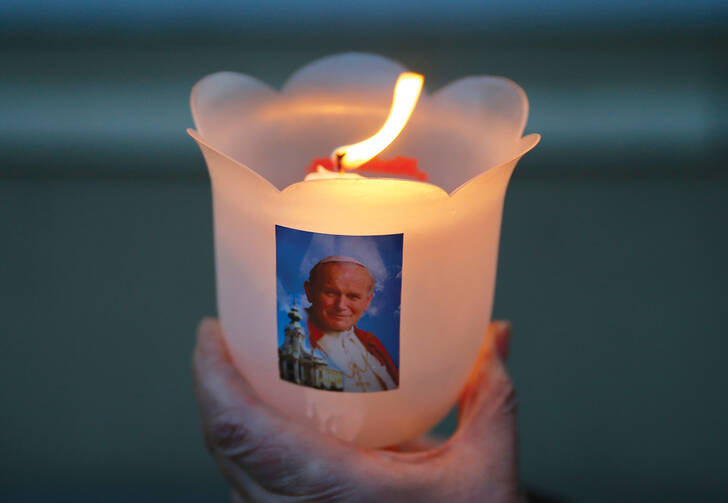As Pope John Paul II celebrates 25 years in office, the world is taking stock of a pontificate that has helped shape political events, set new directions for the Catholic Church and offered spiritual inspiration to millions of people around the globe.
By any measure, this is a papacy for the ages. Since his election on Oct. 16, 1978, Pope John Paul has delivered more speeches, met with more world leaders, canonized more saints and kissed more babies than any previous pontiff. Visiting 129 countries—from the steppes of Asia to the Rocky Mountains—he has implemented the church’s own form of globalization. And in more than 50 major documents, on themes ranging from economics to the rosary, he has brought the Gospel and church teachings to bear on nearly every aspect of modern life. […]
The first non-Italian pontiff in 455 years, Pope John Paul II declared early on that the Second Vatican Council had set his agenda. In particular, his global ministry quickly focused on Vatican II’s engagement with modern culture. As for teaching, the pope has penned three major encyclicals on economic and social justice issues and has addressed the rich-poor imbalance continent by continent in post-synodal documents.
Over the last 10 years, he also has authored three other encyclicals that strongly challenge what he sees as a prevailing moral relativism in postmodern society. “Veritatis Splendor” (1993) spoke of the truth of the church’s moral teachings, “Evangelium Vitae” (1995) defended the inviolability of human life against what the pope calls a “culture of death,” and “Fides et Ratio” (1998) argued that human reason cannot be detached from faith in God.
Meanwhile, under his guidance, Vatican agencies have issued important instructions on such specific questions as foreign debt, in vitro fertilization, the arms industry, the role of the mass media and the impact of the Internet.
Through all these pronouncements runs a central theme: that human freedom becomes destructive when people forget they are created in God’s image. Whether an unborn child, an impoverished African or an elderly shut-in, the pope says, every human being has a value that goes beyond earthly advantages and accomplishments.
While pushing Catholic teaching into virtually every area of modern life, the pope also has taken the measure of the church’s past mistakes. At his insistence, the church acknowledged historical errors in condemning the 16th-century astronomer Galileo Galilei, in participating in European religious wars and even in its missionary approach in some New World territories.
Against considerable resistance within his own Vatican hierarchy, the pope commissioned critical studies on the church’s role in the Inquisition and the Crusades and on the failings of Christians during the Holocaust.
In the area of interreligious relations, Pope John Paul has reached out in ways that were once considered impossible or even heretical. In 1986 he visited a Jewish synagogue in Rome, then in 2000 prayed at the Western Wall in Jerusalem—a gesture that won the hearts of many Jews worldwide. In Syria, he became the first pope to visit a mosque, and in Morocco he spoke to thousands of cheering Muslim youths. Twice he convened leaders of other religions and other churches for prayer meetings in Assisi, where participants denounced all acts of war and terrorism carried out in the name of religion.
Within the church, the pope has been no less dynamic. He has disciplined dissenting theologians and self-styled “traditionalists,” promulgated a new Code of Canon Law, issued new directives calling for clearer Catholic identity in church universities and defended with the full weight of his authority the church’s all-male priesthood. […]
During his papacy, the church has expanded greatly in Africa and made significant advances in Asia and Oceania. This distinctly third world tilt has been spotlighted during the pope’s more than 100 foreign trips, when he has used local customs in his liturgies, spoken the native language and praised indigenous writers and thinkers.
But the trips have enormous missionary objectives as well. While respectful of the non-Catholic or non-Christian majorities along his itinerary, the pope has always presented the figure of Christ and the Gospel message to any and all of his listeners.
That is in keeping with the pope’s conviction that while all people can be saved, Christ is the unique savior for all people—a point made forcefully in the controversial document “Dominus Iesus,” which emphasized proclamation of Christ over dialogue.
Visiting India in 1999, the pope delineated the church’s approach on the Asian continent, where he predicted “a great harvest of faith” in the years to come. He praised his hosts’ non-Christian spiritual traditions but also preached the Gospel, and said the best way for Christians to evangelize was by living the Gospel values.
As the pope has aged, his rapport with young people has remained consistently—and sometimes amazingly—fresh and energetic. World Youth Day celebrations, like the most recent one in Toronto in 2002, seem to bring out the pope’s good humor and vigor. He jokes more easily with the young, but there is a serious side to all this, too. […]
“At the start of the 21st century, the pope continues to open people up to the transcendent, telling them that we’re more than genetics, we’re more than psychology, we’re more than DNA,” said [Vatican spokesman Joaquín] Navarro-Valls. This is a message that is resonating with Catholics and non-Catholics around the world, he added. […]
How will Pope John Paul II be remembered in the history books? On an ecclesial level, for his energetic missionary ministry that took him around the globe and saw rapid church growth in the third world. Internationally, he will go down as the godfather of Communism’s demise in Europe, and as a moral statesman whose pronouncements on poverty, human life and war often challenged conventional policies. But much of the world will remember him simply as a man of deep prayer, whose spiritual intensity impressed believers of every faith.








